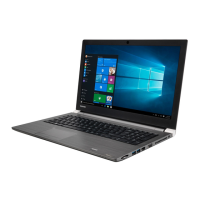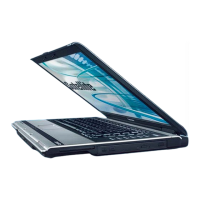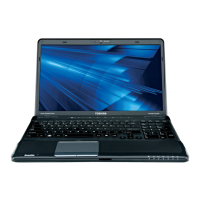
Do you have a question about the Toshiba Satellite A80 Series and is the answer not in the manual?
Details copyright ownership and reproduction rights for the manual.
States TOSHIBA's liability regarding manual accuracy and usage.
Information regarding compliance with FCC rules for digital devices.
Contact details for Electromagnetic Compatibility (EMC) information.
Provides essential safety guidelines for operating the portable computer.
Highlights the main features and benefits of the Satellite A80 series.
Specifies the CPU models and the components of the chip set.
Details memory slots, cache, video controller, and BIOS features.
Describes battery pack, AC adapter, and touchpad functionalities.
Covers display resolutions and various disk drive types.
Details on slots, ports like USB, i.LINK, and multimedia connectors.
Configuration for modem, LAN, wireless LAN, and Bluetooth.
Explains special keys, hotkeys, and keypad overlay functions.
Details on Power Saver, ConfigFree, and other system utilities.
Guidance on creating an ergonomic and safe work environment.
Steps for connecting the AC adapter and turning on the computer.
Explains shutdown, hibernation, and standby modes.
How to use the touchpad and its control buttons.
Instructions for setting up and connecting the internal modem.
Steps for connecting to LAN and Wireless LAN networks.
Guidance on loading, removing, and using CD/DVD drives.
Explanation of F1-F12 keys and Fn key combinations.
List and explanation of hotkeys and keypad overlay functions.
Details on power indicators and battery status.
Guidance on battery usage, safety, and charging procedures.
Instructions for replacing the battery and maximizing its lifespan.
How to launch and navigate the HW Setup utility.
Settings for boot order, keyboard, USB, and LAN wake-up.
Steps for installing and removing PC cards.
Details on memory cards and installing memory modules.
How to connect external monitors, TVs, and i.LINK devices.
General guidelines for identifying and solving computer problems.
Checklists for common hardware and system problems.
Solutions for issues with power, battery, drives, and peripherals.
Physical dimensions and weight of the computer.
Ambient temperature and humidity requirements for operation.
Detailed technical specifications for the internal modem.
Table listing available display resolutions and refresh rates.
Details on length, wire size, current, voltage ratings, and agencies.
Lists certification bodies and shows plug shapes for various regions.
A list of common abbreviations used in the manual.
Definitions for essential computer hardware and software terms.











